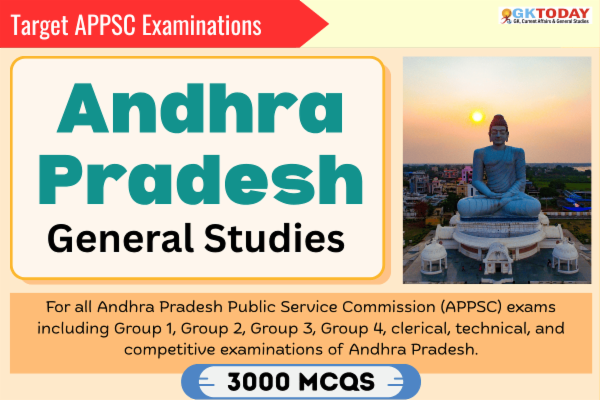States PCS: Andhra Pradesh GK For APPSC Examinations
For all Andhra Pradesh Public Service Commission (APPSC) exams including Group 1, Group 2, Group 3, Group 4, clerical, technical, and competitive examinations of Andhra Pradesh.
1. Who among the following Golconda rulers was the contemporary of Sri Krishna Deva Raya?
[A] Mohammad Shah
[B] Quli-Qutub Shah
[C] Ibrahim
[D] Abdullah Qutb Shah
Show Answer
Correct Answer: B [Quli-Qutub Shah ]
Notes:
Quli-Qutub Shah (1512-1543) was the contemporary of Sri Krishna Deva Raya (1509-1529) and Achyutha Raya (1529-1549).
2. In which year Mandal system introduced in Andhra Pradesh?
[A] 1980
[B] 1983
[C] 1985
[D] 1989
Show Answer
Correct Answer: C [1985]
Notes:
The AP government announced the formation of the Mandal system on May 25, 1985
3. During whose regime George Bush visited Andhra Pradesh?
[A] Chandrababu Naidu
[B] YS Rajasekhar reddy
[C] Kirankumar reddy
[D] None of the above
Show Answer
Correct Answer: B [YS Rajasekhar reddy]
Notes:
George Bush was the second US president to visit Andhra Pradesh. He visited Andhra Pradesh in 2006 when YSR was CM.
Earlier Bill Clinton visited Andhra When Chandrababu Naidu was CM.
4. Who among the following was the last Chief minister of undivided Andhra Pradesh?
[A] K.Rossiah
[B] N. Kirankumar reddy
[C] YS Rajasekhar reddy
[D] None of the above
Show Answer
Correct Answer: B [N. Kirankumar reddy]
Notes:
Nallari Kirankumar reddy was the last Chief minister of undivided Andhra Pradesh.
5. In which district of Andhra Pradesh are the Ketavaram prehistoric rock paintings located?
[A] Nellore
[B] West Godavari
[C] Kurnool
[D] East Godavari
Show Answer
Correct Answer: C [Kurnool]
Notes:
The Ketavaram prehistoric rock paintings, dating to over 5,000 years ago, are located in Kurnool district of Andhra Pradesh. They represent hunting scenes and depict the day-to-day life of the Stone Age people.
6. Which political party is Peethala Sujatha affiliated with?
[A] Telugu Desam Party
[B] YSR Congress Party
[C] Indian National Congress
[D] Bharatiya Janata Party
Show Answer
Correct Answer: A [Telugu Desam Party]
Notes:
Peethala Sujatha is a leader of the Telugu Desam Party from Andhra Pradesh and has served as a minister in the N. Chandrababu Naidu ministry.
7. Which caste from Coastal Andhra Pradesh is historically known for serving as military generals in the Vijayanagara Empire and is currently among the wealthiest and most influential groups in Andhra Pradesh and Telangana?
[A] Kammas
[B] Reddys
[C] Velamas
[D] Kapus
Show Answer
Correct Answer: A [Kammas]
Notes:
Kammas were military generals in Vijayanagara Empire and are now a wealthy, influential group in Andhra Pradesh and Telangana.
8. Who was the first Lok Sabha MP from Kakinada representing the Communist Party of India (CPI) in 1952?
[A] Moturi Satyanarayana
[B] Dr. Chelikani Venkata Rama Rao
[C] Dasari Narayana Rao
[D] Ganti Jogi Somayaji
Show Answer
Correct Answer: B [Dr. Chelikani Venkata Rama Rao]
Notes:
Dr. Chelikani Venkata Rama Rao was the first CPI MP from Kakinada in 1952 Lok Sabha.
9. Who founded Nizamabad Law College and also served as the Nizamabad Municipal Chairman?
[A] Dr. P. V. Narasimha Rao
[B] K. Chandrashekar Rao
[C] Dr. Y. S. Rajasekhara Reddy
[D] Dr. Vala Chakradhar Rao
Show Answer
Correct Answer: D [Dr. Vala Chakradhar Rao]
Notes:
Dr. Vala Chakradhar Rao founded Nizamabad Law College and served as Nizamabad Municipal Chairman.
10. Where was Nallam Venkataramayya born?
[A] Chennai
[B] Mummidivaram
[C] Visakhapatnam
[D] Vijayawada
Show Answer
Correct Answer: B [Mummidivaram]
Notes:
Nallam Venkataramayya was born in Mummidivaram in 1943.

